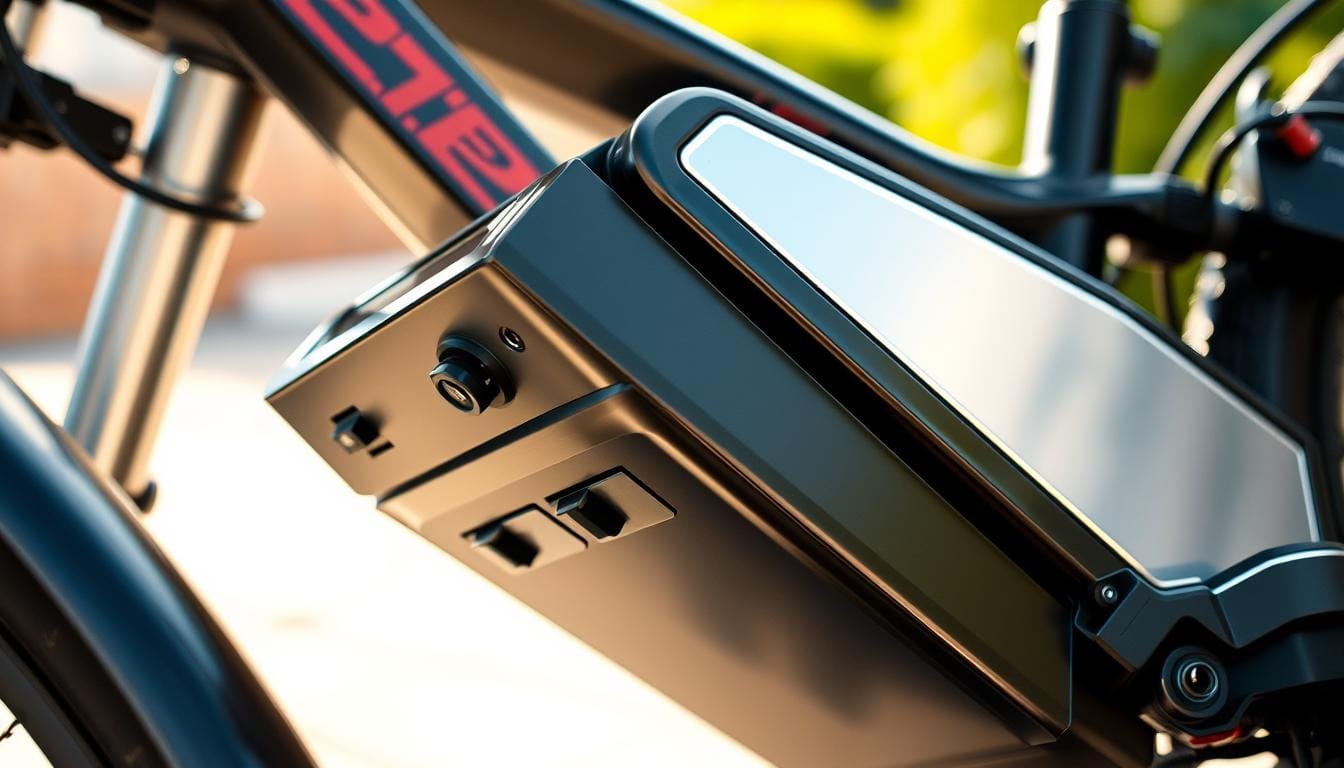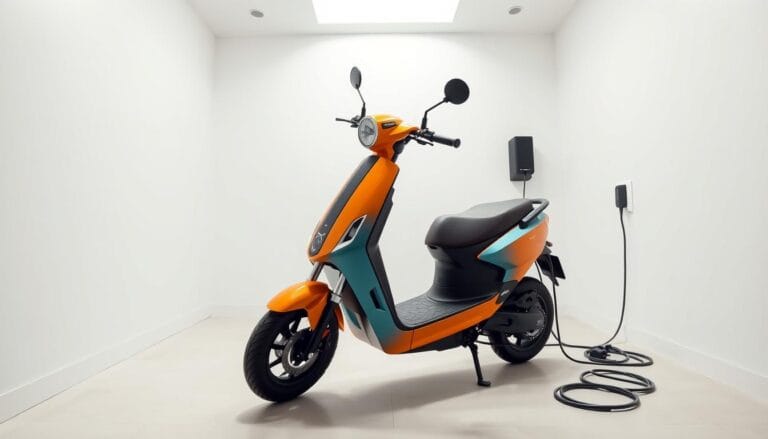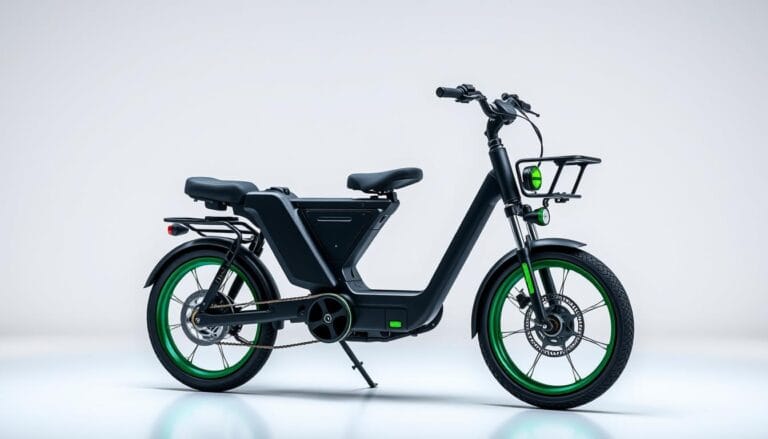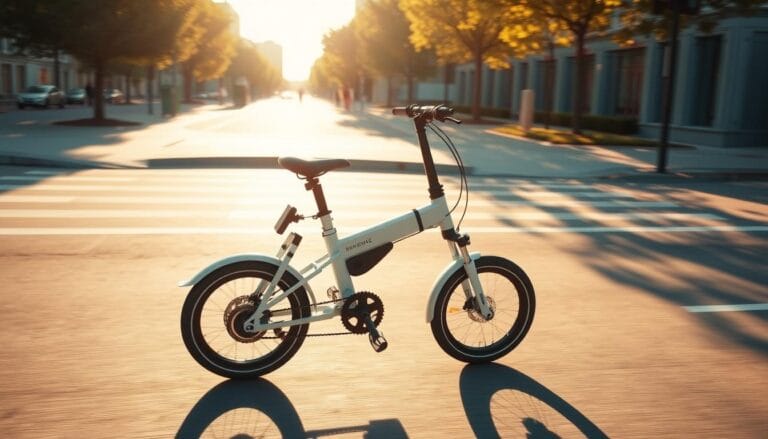Unlock More Range: The Top Electric Bike Battery Options
When you’re looking to buy an electric bike, the battery is key. Most e-bikes use lithium-ion batteries, which are known for their power and long life. Picking the right battery can greatly improve your ride, letting you go further with ease.
Choosing the best electric bike battery means understanding what affects battery life. Charging between 20% and 80% helps your battery last longer. Also, using less pedal assist and planning your route can save power. With the right battery, you can ride longer and enjoy your journey more.
If you’re searching for a lithium ion battery for your electric bike or want to upgrade, look at the top options. The right battery boosts your e-bike’s performance and range. In this article, we’ll explore what to look for in an electric bike battery.
Table of Contents
Understanding Electric Bike Batteries
When you’re looking to buy an electric bike, knowing about the battery is key. The rechargeable ebike battery is what powers your ride. Learning how to save battery life is important.
Choosing the right motor level and charging the battery right are also key. This ensures your bike runs well.
A high capacity electric bike battery means longer rides. It’s great for commuters or those who love long rides. But, the battery’s performance can change based on the terrain and your weight.
Regular care, like cleaning and proper storage, helps your battery last longer. This keeps it performing well.
Here are some important facts about electric bike batteries:
- Most electric bikes use lithium-ion batteries. They last from 500 to 1000 charge cycles.
- E-bike batteries usually last 500-1000 charge cycles before they lose charge.
- Battery sizes for e-bikes vary. You’ll find 10.4Ah, 11.6Ah, 14Ah, 21Ah, or 25Ah. Higher Ah means longer rides.
Understanding electric bike batteries helps you choose the right one. This ensures your bike meets your needs.
Types of Electric Bike Batteries
Choosing an electric bike battery can be a bit tricky. There are many options, each with its own benefits. We’ll look at lithium-ion, lead-acid, and new technologies.
Lithium-ion batteries are popular for their high energy and long life. They’re also light. But, they can cost more. Some people look for cheaper options like lead-acid batteries. Lead-acid batteries don’t last as long and have a shorter range, but they’re cheaper.
Here are some key characteristics of different electric bike battery types:
- Lithium-ion batteries: high energy density, long lifespan, relatively low weight
- Lead-acid batteries: lower energy density, shorter lifespan, less expensive
- Nickel-Metal Hydride (NiMH) batteries: better range than lead-acid, but less than lithium-ion
New technologies like solid-state batteries are also being developed. They promise even better performance and range. When picking a battery, think about your budget, how you ride, and where you’ll be riding. With the right care, an electric bike battery can last for years.
Battery Capacity and Range Explained
Understanding the link between battery capacity and range is key for electric bikes. A high capacity battery means longer rides and more power. It’s important to pick the right motor level and charge the battery right to save power.
A long-lasting battery is good for the planet and your wallet. The e-bike’s range depends on the battery. Things like rider weight, terrain, and how often you use the motor matter too. For example, a 48V 20Ah battery lasts twice as long as a 48V 10Ah one.
Factors Affecting Range
Several things can change your e-bike’s range, including:
- Battery capacity, measured in amp-hours (Ah)
- Voltage, with higher voltages providing more power
- Rider weight and cargo
- Terrain and elevation
- Motor usage frequency
Knowing these factors helps you pick a battery that lasts longer. A high capacity, eco-friendly battery means more range and a greener ride. Regular care, like checking tire pressure and brake adjustments, boosts battery life.
In short, the right battery makes a big difference in your ride. Look for a high capacity, long-lasting, eco-friendly battery for a better experience.
Charging Options for Electric Bike Batteries
There are several ways to charge your electric bike battery. You can use a standard charger, a fast charger, or even a portable power bank. Knowing your options helps you get the most from your battery.
A lithium ion battery for electric bikes can be charged with a standard charger. But, if you want to charge faster, a fast charger is a good choice. Fast chargers can fill your battery to 80% in under an hour, perfect for long rides.
You can also charge your battery with a portable power bank. This is handy when you’re away from a standard charger. Just make sure the power bank fits your battery and provides the right voltage and current.
When charging your battery, keep these tips in mind:
* Always use a charger that’s right for your battery to avoid damage.
* Don’t overcharge, as it can shorten your battery’s life.
* Keep the charge level above 20% to prevent wear.
* Check your battery and charger regularly for any damage or wear.
What to Look for in an Electric Bike Battery
When picking an electric bike battery, there are important things to think about. You might be looking for a battery that lasts long or one that’s reliable. The battery’s weight is also key because it affects how the e-bike handles.
A top-notch electric bike battery should be tough and weather-proof. It should handle different conditions well and last a long time. It’s also smart to check the warranty and how long the battery will last. A lithium-ion battery, for example, can last 2 to 3 years or go through 500 to 1,000 charge cycles.
- High capacity to ensure a long range
- Durable and weather-resistant design
- Good warranty and lifespan
- Lightweight to improve handling and performance
By looking at these points and picking the right battery, you’ll have a great time riding. You’ll also get the most out of your e-bike.
Top Electric Bike Battery Brands
Choosing the right electric bike battery is key. You want one that’s reliable, performs well, and is affordable. A good battery can extend your ride and make it more efficient. Let’s look at the best electric bike battery brands and what they offer.
Bosch, Shimano, and Samsung are leaders in electric bike batteries. They use the latest technology and offer batteries for all budgets. For example, LG Chem and Panasonic are great for those on a budget but want quality.
Here are some key features and benefits of the top electric bike battery brands:
- Bosch: Known for their long lifespan and efficient energy management, contributing to reliable performance in various conditions.
- Shimano: Offers high-quality batteries with excellent durability and weather resistance, making them a great choice for frequent riders.
- Samsung: Provides a balance between performance and price, ensuring reliability and safety with features to prevent overcharging and overheating.
When picking a battery, think about its capacity, voltage, and weight. A bigger capacity means longer rides. Higher voltage means more power. Look for lithium ion batteries for better energy storage and longer rides.
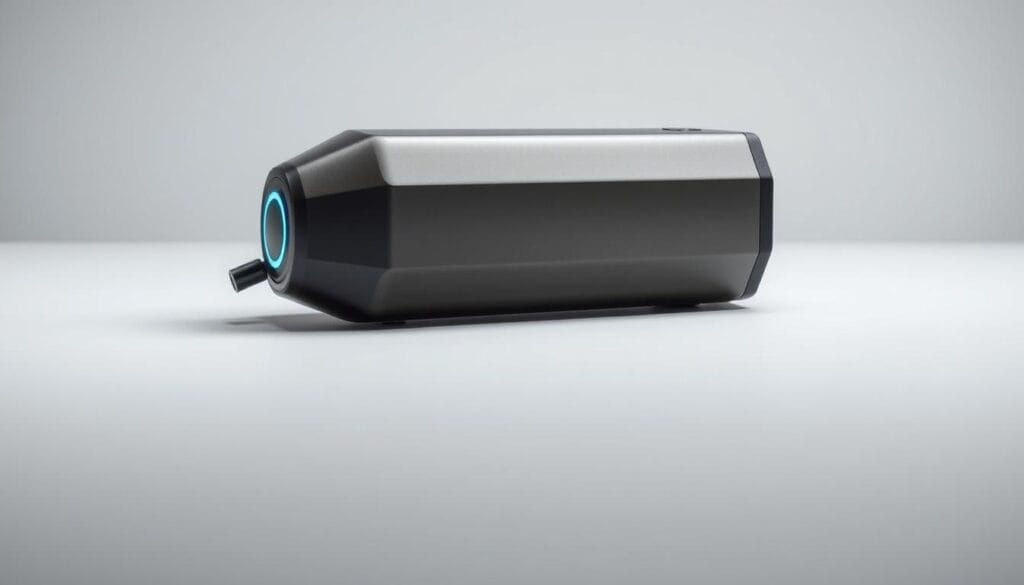
In conclusion, top brands offer many options for different needs and budgets. By considering capacity, voltage, and weight, and choosing a reputable brand, you’ll get a better ride.
| Brand | Capacity | Weight | Price |
|---|---|---|---|
| Bosch | 300-625Wh | 3.5kg | High |
| Shimano | 630Wh | 3.15kg | High |
| Samsung | 400-600Wh | 2.9kg | Moderate |
Battery Maintenance Tips for Longevity
To keep your electric bike battery in top shape, regular care is key. A well-maintained battery makes your rides better. You should check it often, charge it right, and store it properly. For more tips on e-bike battery care, check out e-bike maintenance guide.
Here are some important tips for your rechargeable ebike battery:
- Regularly check the battery for wear and tear signs
- Store it at room temperature with a 50% charge when not in use
- Stay away from extreme temperatures and avoid overcharging
By following these tips, you can make your eco-friendly electric bike battery last longer. A well-cared-for battery can last 3 to 5 years. Proper maintenance ensures it works its best.
Troubleshooting Common Battery Issues
Using your electric bike can lead to battery problems. To keep your electric bike battery working well, it’s key to spot and fix common issues. A big sign of battery wear is when it doesn’t last as long as it used to. If your lithium ion battery for electric bike isn’t lasting as long, it might be worn out.
To solve battery problems, first check how you charge it. Make sure you’re not overcharging it, as this can harm the battery. Also, look for any loose or corroded connections that might affect charging. Keeping the battery in good shape, like checking for damage and storing it right, can also help.
Signs your best electric bike battery needs a new one include a drop in range, longer charging times, and physical damage. Knowing these signs and taking care of your battery can make it last longer and work better.
- Charge the battery at least once a month to keep it in top shape
- Avoid letting it fully discharge to prevent damage
- Store it at 30-60% charge when not using it
Upgrading Your Electric Bike Battery
Thinking about upgrading your electric bike battery? It’s key to weigh the pros and cons. A high capacity battery means more range and better performance. This makes your rides more fun and easy.
But, is it really needed? And does it fit your budget? These are important questions to ask.
A long-lasting battery is a smart choice. It can handle many charge cycles and stay strong over time. Look for one that’s eco-friendly too. This helps reduce waste and protects our planet.
When looking to upgrade, consider a few things:
- Battery capacity: A bigger battery means more range and better performance.
- Charge cycles: Choose a battery that can handle lots of charges without losing power.
- Compatibility: Make sure the new battery works well with your bike’s motor and controller.
By picking the right battery, you’ll get a better riding experience. Do your homework and compare options. Find the best one for your needs and wallet.
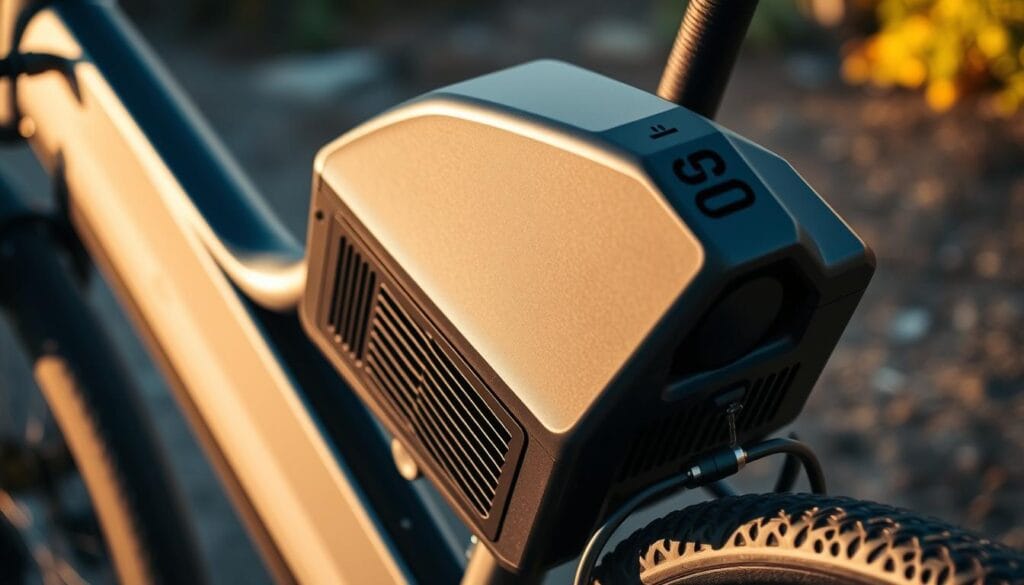
Environmental Considerations of Electric Bike Batteries
When looking to buy an eco-friendly electric bike battery, think about its environmental impact. Electric bike batteries can harm the environment if not disposed of right. But, by picking a rechargeable ebike battery and using eco-friendly practices, you can lessen your environmental footprint.
To cut down on environmental harm, recycle your old electric bike battery. You can take it to a recycling center or join a battery recycling program. Also, many makers now use green methods in making batteries, like using recycled stuff and cutting down on waste.
Benefits of Sustainable Battery Production
Sustainable battery making has many perks. It cuts down on waste, saves natural resources, and lowers harmful emissions. By picking a battery from a green-focused maker, you help lessen the production’s environmental harm. Rechargeable ebike batteries are also good, as they can be used many times, cutting down on the need for new ones and waste.
Reducing Your Environmental Footprint
To lessen your environmental impact, consider these tips:
- Choose an eco-friendly electric bike battery
- Recycle your old battery responsibly
- Follow sustainable practices in your daily life, such as reducing energy use and using public transport
By doing these, you can help reduce the environmental harm of your electric bike battery. This way, you contribute to a greener future.
Cost of Electric Bike Batteries: What You Should Know
When you’re looking to buy an electric bike, the battery cost is key. The price of an affordable electric bike battery can change a lot. It depends on the brand, quality, and how much power it holds. Knowing the difference between value and price can help you choose the right battery.
A best electric bike battery can cost anywhere from $300 to over $1,000, not including the bike. The price of a top-notch electric bicycle battery is affected by the brand, quality, and power. Bigger batteries give you more range but cost more.
- 300 Wh: 4.2 pence per charge, £21 for 500 charges, £42 for 1000 charges
- 400 Wh: 5.6 pence per charge, £28 for 500 charges, £56 for 1000 charges
- 500 Wh: 7 pence per charge, £35 for 500 charges, £70 for 1000 charges
- 600 Wh: 8.4 pence per charge, £42 for 500 charges, £84 for 1000 charges
Future Trends in Electric Bike Battery Technology
The electric bike market is growing fast, and battery tech is getting better. Soon, you’ll see solid-state batteries that are safer, charge faster, and hold more energy. These new batteries will make your rides better and safer.
Expect batteries that last longer and need to be replaced less often. Companies are working on better ways to keep batteries cool and safe. This means fewer worries about overheating.
Look for e-bikes that are more affordable and come in many styles. As cities get more bike-friendly, electric bikes will be even more popular. Keep up with these tech advances to enjoy a greener, more fun ride.

